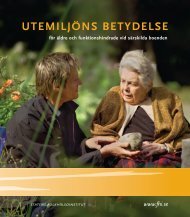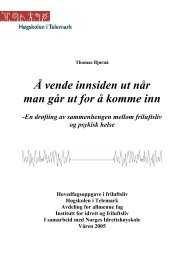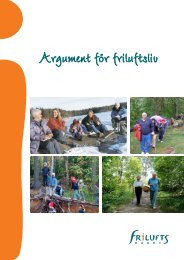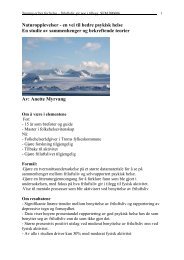Green Care: A Conceptual Framework - Frisk i naturen
Green Care: A Conceptual Framework - Frisk i naturen
Green Care: A Conceptual Framework - Frisk i naturen
You also want an ePaper? Increase the reach of your titles
YUMPU automatically turns print PDFs into web optimized ePapers that Google loves.
1925 1), wanted to make a difference to the lives of marginalised people<br />
and so established the first Camphill community for children with special<br />
needs in Camphill House near Aberdeen, Scotland in 1940 (Association of<br />
Camphill Communities in Great Britain, 2009). Since then, Camphill has<br />
grown into a world-wide network of more than 100 communities in over 20<br />
countries where over 3,000 children and adults with learning disabilities,<br />
mental health problems and other special needs live and work together in a<br />
therapeutic community, many of which are in countryside settings.<br />
During the 1950s and 60s in the UK hospital farms and gardens gradually<br />
closed. This came about because of changes in health policy, disquiet about<br />
hospitals operating large farms, disquiet, also, about the use of patients as<br />
unpaid labour in hospitals. Such a pattern of systematic closure was not<br />
uniformly repeated across Europe but nonetheless hospitals’ reliance on<br />
farming and gardening generally waned for a while. However, interest in<br />
the therapeutic potential of the natural environment is once again growing<br />
as this conceptual framework shows. Perhaps one important turning point<br />
in promoting this growth was Ulrich’s observation that patients recovering<br />
from cholecystectomy (gall bladder surgery) fared better if they had a view<br />
of trees from their hospital bed than if that view was of a brick wall (Ulrich<br />
1984). This also showed that the power of nature in promoting health could<br />
be studied and measured.<br />
The use of nature-based activities as a form of intervention for promoting<br />
health and well-being has not disappeared but a variety of approaches<br />
have evolved, which under the umbrella of green care, are the subject of<br />
this work. What is particularly interesting is that these approaches provide<br />
services for the same client groups as the old hospital and asylum farms and<br />
market gardens, namely those with mental health problems and learning<br />
difficulties. However, the client base has also widened to include almost all<br />
vulnerable and excluded groups.<br />
2.3 Disconnection and reconnection from nature<br />
An important aspect of a conceptual framework for green care is<br />
understanding what conditions must be met for people to benefit<br />
psychologically from belonging to a green care program. The idea that<br />
we may be connected to, or feel a sense of connectedness with, natural<br />
things occurs frequently in the academic and more popular literature on<br />
1 Much of Steiner’s writings are available on the internet from the Rudolph Steiner Archive: www.rsarchive.org<br />
17















